Tariff Resilience: How Canada Is Turning U.S. Trade Tensions Into a ‘Buy Canadian’ Movement

Tariff Resilience defines Canada’s bold response to escalating U.S. trade tariffs in 2025, transforming economic challenges into a vibrant ‘Buy Canadian’ movement.
As the U.S. imposes sweeping duties 25% on most Canadian goods and 50% on steel and aluminum Canadians are rallying to bolster local industries.
This isn’t just about weathering a storm; it’s about redefining national pride through economic action. From policy countermeasures to grassroots consumer shifts, Canada is proving that adversity can spark innovation and unity.
This article explores how Tariff Resilience is reshaping Canada’s economy, with practical examples, real-time insights, and a forward-looking perspective on thriving amid trade tensions.
The U.S.-Canada trade relationship, historically robust with $2.5 billion in daily cross-border goods and services, faces unprecedented strain.
President Donald Trump’s executive orders, starting February 1, 2025, introduced tariffs citing issues like fentanyl and immigration, despite data showing less than 1% of U.S. fentanyl originates from Canada.
Canada’s countermeasures, including 25% tariffs on $30 billion of U.S. goods, signal a strategic pivot. Meanwhile, the ‘Buy Canadian’ movement gains momentum, with consumers and businesses prioritizing local products.
This article unpacks how Tariff Resilience is driving economic adaptation, supported by policy, community action, and a renewed focus on diversification.
The Economic Fallout: Understanding U.S. Tariffs
U.S. tariffs, escalating to 35% on non-CUSMA-compliant goods by August 2025, hit Canadian exports hard.
Steel, aluminum, and autos face severe disruptions. Canadian businesses, reliant on the U.S. for 75% of exports, scramble to adapt.
Supply chains falter, raising costs for both nations. Inflation looms as American consumers face higher prices for Canadian goods.
Canadian countermeasures aim to protect jobs but increase U.S. product costs. The integrated North American economy suffers, risking long-term competitiveness.
The auto sector, a cornerstone of Ontario’s economy, exemplifies the pain. Stellantis and General Motors reported work stoppages and layoffs.
A Windsor auto worker, Sarah Thompson, shared, “We’re cutting shifts, but I’m buying Canadian-made parts now.”
++ Canadian Dollar Strengthens on Global Trade Optimism: What It Means for Canadians
This shift reflects Tariff Resilience at a personal level. Small businesses, too, face rising input costs, forcing tough choices. Yet, Canada’s economy shows grit, avoiding recession with flat GDP growth in Q2 2025.
Despite the strain, opportunities emerge. Tariffs push Canadian firms to rethink supply chains, seeking non-U.S. suppliers.
This pivot, though costly, fosters innovation. For instance, a Manitoba manufacturer switched to Brazilian steel, reducing U.S. dependency.
The government’s $40 billion liquidity injection via tax deferrals helps businesses stay afloat. These measures cushion the blow, but long-term resilience demands more than short-term fixes.

Policy Countermeasures: Canada’s Strategic Response
Canada’s government swiftly countered U.S. tariffs with 25% duties on $30 billion of U.S. goods, effective March 4, 2025. This targeted retaliation aims to pressure the U.S. to reconsider.
Prime Minister Mark Carney’s administration also launched the Large Enterprise Tariff Loan Facility (LETL), aiding businesses facing liquidity crunches.
Employment Insurance reforms, like waiving waiting periods, support workers. These policies embody Tariff Resilience by prioritizing economic stability.
The remission framework for automakers incentivizes local production. CUSMA-compliant vehicles dodge some tariffs, preserving jobs.
Also read: Business Sentiment Improves: Firms Less Worried About U.S. Tariffs—But Still Cautious
For example, a Toronto-based parts supplier now prioritizes Canadian steel, boosting local mills. Provincial governments, like Yukon’s, are excluding U.S. goods from procurement.
This coordinated “Team Canada” approach, as Carney calls it, aligns federal and provincial efforts. It’s a chess move, not a knee-jerk reaction.
Border security investments, including $1.3 billion for fentanyl detection, address U.S. concerns while protecting trade.
A 97% drop in fentanyl seizures at the Canada-U.S. border in January 2025 underscores progress. These actions counter Trump’s narrative, showing Canada’s commitment to cooperation.
By blending diplomacy and firm policy, Canada navigates this trade war with calculated resolve.
The ‘Buy Canadian’ Movement: A Cultural Shift
The ‘Buy Canadian’ movement is more than a slogan it’s a cultural awakening. Canadians are swapping U.S. brands for local alternatives, from A&W over McDonald’s to CBC Gem over Netflix.
Liquor stores pull American whiskey, stocking Alberta-distilled spirits instead. This shift, fueled by apps like Shop Canadian Stuff, empowers consumers to choose local. It’s Tariff Resilience rooted in community action.
Social media amplifies this trend. A Vancouver mom, Emily Chen, posted about switching to Canadian-made diapers, sparking a viral thread.
Read more: GST Relief & Housing Measures: Affordable Housing and Groceries Act Impacts You
Retailers report a 15% surge in demand for Canadian goods since March 2025. Small businesses benefit as consumers prioritize local grocers over U.S. chains.
This isn’t just economics it’s a statement of sovereignty. Why should Canadians fund U.S. brands when local options thrive?
The movement extends to services. A Calgary marketing firm now sources Canadian software, cutting ties with U.S. providers.
This grassroots push reduces reliance on American imports, which dropped 10% in Q2 2025.
By choosing Canadian, consumers and businesses are weaving a stronger economic fabric, proving that unity can outlast trade disputes.
Diversifying Trade: Looking Beyond the U.S.
Tariffs expose Canada’s over-reliance on the U.S. market, prompting a pivot to global partners. Exports to non-U.S. countries rose 5% in Q1 2025.
China and India, despite past tensions, offer opportunities. UBC Sauder’s Dr. Samuel Roscoe urges trade deals with these nations.
A Nova Scotia fishery now exports lobster to Asia, offsetting U.S. losses. This is Tariff Resilience through diversification.
Alberta’s energy sector, largely CUSMA-compliant, faces minimal tariffs, supporting GDP growth of 2.4% in 2025. Yet, global oil price drops pose risks.
Canadian businesses are investing in value-added products, like turning softwood lumber into furniture for export.
This shift increases “product value density,” making distant markets viable. Canada’s 15 free trade agreements with 51 countries provide a foundation for expansion.
The government’s push for “nation-building projects,” like energy corridors, aims to diversify infrastructure.
A hypothetical analogy: if Canada’s economy were a ship, tariffs are a storm, but diversification is a new sail, catching winds from global markets. By exploring new trade horizons, Canada reduces vulnerability and builds long-term resilience.
Economic Impacts and Future Outlook
The Bank of Canada notes resilience, with no recession in 2025 despite a 1.5% GDP drop in Q2. CUSMA exemptions lower the effective tariff rate to 7%.
However, sectors like steel face 50% U.S. tariffs, risking 23,000 jobs. Inflation hovers near 2%, balancing tariff-driven price hikes with weaker demand. Canada’s economy walks a tightrope, but it’s holding steady.
| Sector | U.S. Tariff Rate | Canadian Counter-Tariff | Impact |
|---|---|---|---|
| Steel | 50% | 25% | 23,000 jobs at risk |
| Aluminum | 50% | 25% | 9,500 jobs at risk |
| Automobiles | 25% | 25% (CUSMA-compliant exempt) | Layoffs, work stoppages |
| Energy/Potash | 10% | None | Minimal disruption |
Businesses adapt by certifying CUSMA compliance, with 94% of exports potentially exempt. A Montreal electronics firm, for instance, streamlined paperwork to avoid tariffs.
Yet, CUSMA’s 2026 renegotiation looms as a potential flashpoint. If talks fail, tariffs could spike, threatening growth. Canada’s focus on diversification and domestic investment is a proactive hedge against this uncertainty.
Long-term, Tariff Resilience could redefine Canada’s economic identity. By fostering innovation, like a Saskatchewan farmer exporting canola to Europe, Canada builds self-reliance.
The government’s $1.3 billion border plan and infrastructure investments signal commitment to stability. While trade tensions persist, Canada’s blend of policy, consumer action, and global outreach charts a path to a stronger, more independent economy.
Conclusion: A Nation Rising to the Challenge
Tariff Resilience is Canada’s answer to U.S. trade aggression, blending policy, consumer pride, and global ambition.
From counter-tariffs to the ‘Buy Canadian’ surge, Canadians are turning adversity into opportunity. The economy, though strained, avoids collapse, with GDP growth flat but positive.
By diversifying trade and investing in local industries, Canada isn’t just surviving it’s thriving. This moment, like a hockey player shrugging off a hit, shows Canada’s grit.
The path ahead demands vigilance, but the nation’s unified response proves its strength. Let’s keep our elbows up and build a future where Canada’s economy shines, tariff or no tariff.
Frequently Asked Questions
What are the current U.S. tariffs on Canadian goods?
As of August 2025, U.S. tariffs include 35% on non-CUSMA-compliant goods, 50% on steel and aluminum, and 25% on autos.
How can I support the ‘Buy Canadian’ movement?
Choose Canadian-made products, use apps like Shop Canadian Stuff, and support local businesses. Check labels for “Made in Canada” to start.
